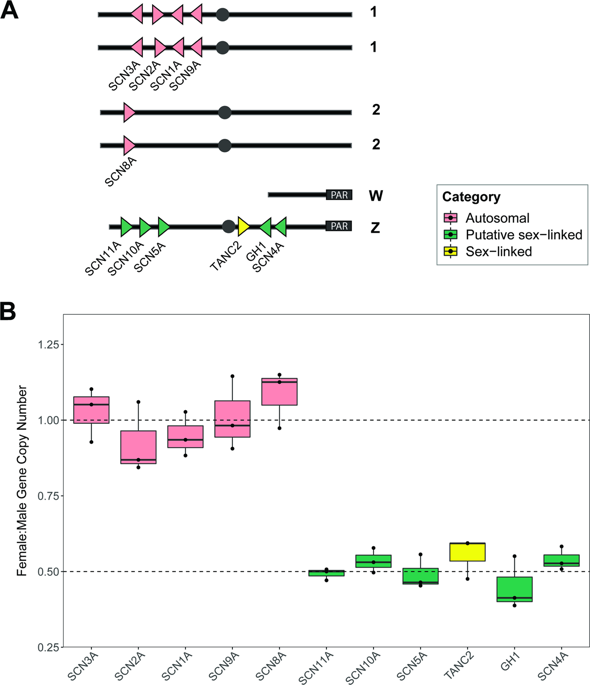Our official English website, www.x-mol.net, welcomes your
feedback! (Note: you will need to create a separate account there.)
Sex linkage of the skeletal muscle sodium channel gene (SCN4A) explains apparent deviations from Hardy–Weinberg equilibrium of tetrodotoxin-resistance alleles in garter snakes (Thamnophis sirtalis)
Heredity ( IF 3.1 ) Pub Date : 2020-02-28 , DOI: 10.1038/s41437-020-0300-5 Kerry L Gendreau 1 , Michael T J Hague 2, 3 , Chris R Feldman 4 , Edmund D Brodie 5 , Edmund D Brodie 2, 6 , Joel W McGlothlin 1
Heredity ( IF 3.1 ) Pub Date : 2020-02-28 , DOI: 10.1038/s41437-020-0300-5 Kerry L Gendreau 1 , Michael T J Hague 2, 3 , Chris R Feldman 4 , Edmund D Brodie 5 , Edmund D Brodie 2, 6 , Joel W McGlothlin 1
Affiliation

|
The arms race between tetrodotoxin-bearing Pacific newts (Taricha) and their garter snake predators (Thamnophis) in western North America has become a classic example of coevolution, shedding light on predator-prey dynamics, the molecular basis of adaptation, and patterns of convergent evolution. Newts are defended by tetrodotoxin (TTX), a neurotoxin that binds to voltage-gated sodium channels (Nav proteins), arresting electrical activity in nerves and muscles and paralyzing would-be predators. However, populations of the common garter snake (T. sirtalis) have overcome this defense, largely through polymorphism at the locus SCN4A, which renders the encoded protein (Nav1.4) less vulnerable to TTX. Previous work suggests that SCN4A commonly shows extreme deviations from Hardy–Weinberg equilibrium (HWE) in these populations, which has been interpreted as the result of intense selection imposed by newts. Here we show that much of this apparent deviation can be attributed to sex linkage of SCN4A. Using genomic data and quantitative PCR, we show that SCN4A is on the Z chromosome in Thamnophis and other advanced snakes. Taking Z-linkage into account, we find that most apparent deviations from HWE can be explained by female hemizygosity rather than low heterozygosity. Sex linkage can affect mutation rates, selection, and drift, and our results suggest that Z-linkage of SCN4A may make significant contributions to the overall dynamics of the coevolutionary arms race between newts and snakes.
中文翻译:

骨骼肌钠通道基因(SCN4A)的性别连锁解释了吊袜带蛇(Thamnophis sirtalis)河豚毒素抗性等位基因的哈代-温伯格平衡的明显偏差
北美西部携带河豚毒素的太平洋蝾螈 (Taricha) 与它们的吊带蛇捕食者 (Thamnophis) 之间的军备竞赛已成为共同进化的经典例子,揭示了捕食者-猎物动态、适应的分子基础和趋同模式进化。蝾螈受到河豚毒素 (TTX) 的保护,河豚毒素是一种神经毒素,可与电压门控钠通道 (Nav 蛋白) 结合,阻止神经和肌肉中的电活动,并使潜在的捕食者麻痹。然而,普通吊袜带蛇 (T. sirtalis) 的种群已经克服了这种防御,主要是通过基因座 SCN4A 的多态性,这使得编码的蛋白质 (Nav1.4) 不易受到 TTX 的影响。以前的工作表明,SCN4A 通常在这些群体中表现出与哈代-温伯格平衡 (HWE) 的极端偏差,这被解释为蝾螈强加选择的结果。在这里,我们表明这种明显的偏差在很大程度上可归因于 SCN4A 的性别连锁。使用基因组数据和定量 PCR,我们表明 SCN4A 位于 Thamnophis 和其他高级蛇的 Z 染色体上。考虑到 Z 连锁,我们发现大多数与 HWE 的明显偏差可以用女性半合子而不是低杂合子来解释。性别连锁会影响突变率、选择和漂移,我们的结果表明 SCN4A 的 Z 连锁可能对蝾螈和蛇之间的共同进化军备竞赛的整体动态做出重大贡献。我们表明 SCN4A 位于 Thamnophis 和其他高级蛇的 Z 染色体上。考虑到 Z 连锁,我们发现大多数与 HWE 的明显偏差可以用女性半合子而不是低杂合子来解释。性别连锁会影响突变率、选择和漂移,我们的结果表明 SCN4A 的 Z 连锁可能对蝾螈和蛇之间的共同进化军备竞赛的整体动态做出重大贡献。我们表明 SCN4A 位于 Thamnophis 和其他高级蛇的 Z 染色体上。考虑到 Z 连锁,我们发现大多数与 HWE 的明显偏差可以用女性半合子而不是低杂合子来解释。性别连锁会影响突变率、选择和漂移,我们的结果表明 SCN4A 的 Z 连锁可能对蝾螈和蛇之间的共同进化军备竞赛的整体动态做出重大贡献。
更新日期:2020-02-28
中文翻译:

骨骼肌钠通道基因(SCN4A)的性别连锁解释了吊袜带蛇(Thamnophis sirtalis)河豚毒素抗性等位基因的哈代-温伯格平衡的明显偏差
北美西部携带河豚毒素的太平洋蝾螈 (Taricha) 与它们的吊带蛇捕食者 (Thamnophis) 之间的军备竞赛已成为共同进化的经典例子,揭示了捕食者-猎物动态、适应的分子基础和趋同模式进化。蝾螈受到河豚毒素 (TTX) 的保护,河豚毒素是一种神经毒素,可与电压门控钠通道 (Nav 蛋白) 结合,阻止神经和肌肉中的电活动,并使潜在的捕食者麻痹。然而,普通吊袜带蛇 (T. sirtalis) 的种群已经克服了这种防御,主要是通过基因座 SCN4A 的多态性,这使得编码的蛋白质 (Nav1.4) 不易受到 TTX 的影响。以前的工作表明,SCN4A 通常在这些群体中表现出与哈代-温伯格平衡 (HWE) 的极端偏差,这被解释为蝾螈强加选择的结果。在这里,我们表明这种明显的偏差在很大程度上可归因于 SCN4A 的性别连锁。使用基因组数据和定量 PCR,我们表明 SCN4A 位于 Thamnophis 和其他高级蛇的 Z 染色体上。考虑到 Z 连锁,我们发现大多数与 HWE 的明显偏差可以用女性半合子而不是低杂合子来解释。性别连锁会影响突变率、选择和漂移,我们的结果表明 SCN4A 的 Z 连锁可能对蝾螈和蛇之间的共同进化军备竞赛的整体动态做出重大贡献。我们表明 SCN4A 位于 Thamnophis 和其他高级蛇的 Z 染色体上。考虑到 Z 连锁,我们发现大多数与 HWE 的明显偏差可以用女性半合子而不是低杂合子来解释。性别连锁会影响突变率、选择和漂移,我们的结果表明 SCN4A 的 Z 连锁可能对蝾螈和蛇之间的共同进化军备竞赛的整体动态做出重大贡献。我们表明 SCN4A 位于 Thamnophis 和其他高级蛇的 Z 染色体上。考虑到 Z 连锁,我们发现大多数与 HWE 的明显偏差可以用女性半合子而不是低杂合子来解释。性别连锁会影响突变率、选择和漂移,我们的结果表明 SCN4A 的 Z 连锁可能对蝾螈和蛇之间的共同进化军备竞赛的整体动态做出重大贡献。







































 京公网安备 11010802027423号
京公网安备 11010802027423号